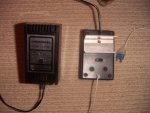Re Evan "Until the input capacitor fails short." I'm not sure I understand.
The input capacitor should not short. Unless it was a faulty component, in which case, yes it could short, but so could every other component and 10,000V could come out of the power point etc etc.
Faulty components happen occasionally, but I suspect it is far more likely a component is being used out of spec (eg a 10V cap on 26V), or a component is the wrong way round.
Occasionally I've been stuck with 26V and anything over 20V, I use a pre-regulator - eg a 7815, and then the 7805. It shares the heat output. But it is also a fudge and not something you design in as it is wasteful of power.
I'd start simple. 9V wallwart. 5V reg. Caps as per the reg datasheet. Torch globe or resistor for current limiting. Red wires for +ve, black for -ve and other colours for the circuit. Leave the picaxe unconnected and test for 5V at the output of the reg.
The input capacitor should not short. Unless it was a faulty component, in which case, yes it could short, but so could every other component and 10,000V could come out of the power point etc etc.
Faulty components happen occasionally, but I suspect it is far more likely a component is being used out of spec (eg a 10V cap on 26V), or a component is the wrong way round.
Occasionally I've been stuck with 26V and anything over 20V, I use a pre-regulator - eg a 7815, and then the 7805. It shares the heat output. But it is also a fudge and not something you design in as it is wasteful of power.
I'd start simple. 9V wallwart. 5V reg. Caps as per the reg datasheet. Torch globe or resistor for current limiting. Red wires for +ve, black for -ve and other colours for the circuit. Leave the picaxe unconnected and test for 5V at the output of the reg.
Last edited:



